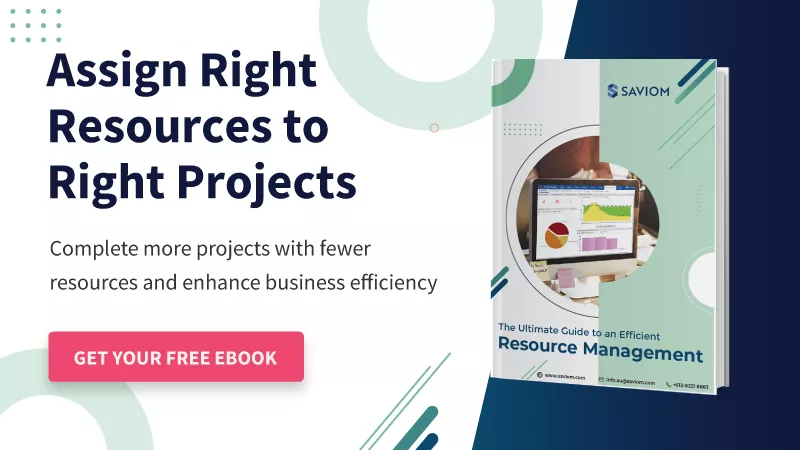The attrition rate of consultants in professional services firms has increased globally over the past 8 years, and reached the average highest at 14% in 2022 ~ Statista
While employee attrition has been a problem for professional services firms, the rise in economic uncertainties, market volatility, and a paradigm shift in the work culture after the pandemic has aggravated it further.
If not addressed appropriately, unplanned attrition can cause a shortage of the right personnel and a loss of billable opportunities, thereby affecting the firm’s sustainability.
Therefore, Professional services firms must strive to curb the rising attrition rate before top-talent employees start walking out the door.
This blog elucidates the impact of unplanned attrition in a PS firm, discusses proven practices to retain them, and how resource management software can help in the process.
But first, let’s understand,
What is unplanned attrition?
Unplanned attrition refers to the departure/exit of employees from an organization for reasons that could have been avoided. Over time, it diminishes the size of the organization’s workforce and affects productivity, revenue, sustainability, etc.
What causes unplanned attrition?
Following are the reasons that can lead to resignation, early retirement, etc., in professional service firms.
Low morale and disengagement – Failure to assign consultants to tasks matching their skills and availability can significantly bring their morale down. For example, assigning niche-skilled employees to a low-priority jobs can make them feel less valued. Moreover, if consultants are not utilized to the best of their capacity, it can cause underutilization. If the situation persists, the employees will be disengaged and lose interest in their daily activities. Eventually, they may look for better opportunities, leading to unplanned attrition.
Burnout – Consultants are often booked on work beyond their capacity, leading to overutilization. It is more noticeable during the seasonal peak when the scarce niche-skilled resources are often booked on multiple projects at once. This stretches their schedules thin. In the long run, this overallocation/utilization of consultants can cause stress and burnout and thus cause attrition.
No career advancement opportunities – Every consultant has personal aspirations and growth goals. They aspire to grow and develop new skills and diversify their career portfolios. If an employee doesn’t get adequate growth opportunities, they may leave for the companies that assist them in their career trajectory, resulting in attrition.
Incompetent pay packages – If a firm fails to match pay scales and compensations with market standards, it can leave consultants discontented. Additionally, biases in salaries in the same roles can also generate dissatisfaction among consultants. As a result, professionals may decide to quit for other firms that facilitate better financial growth.
Inefficient management – Failure to build an efficient leadership generates an environment of discontent among employees. It also gives rise to a lack of trust in the management. Further, micromanagement in the form of frequent check-ins on updates, focusing on irrelevant details, not trusting team members, etc., can demotivate the workforce. As a result, consultants may ultimately leave, causing unplanned attrition.
Read More: The Fundamentals of Leadership in Project Management
Let’s look at the ill effects of unplanned attrition on professional services firms.
How is it detrimental to a professional service firm?
Unplanned attrition can make professional service firms lose their competitive edge, affect team productivity, and reduce overall profitability.
Following are the repercussions of unplanned attrition in detail.
- Affects team dynamics – Effective collaboration is vital for a team’s smooth functioning. So, if one consultant leaves, it affects the whole team’s dynamics, and the tasks that depend on them get delayed. Thus, the team’s efficiency and productivity go down.
- Loss of tacit knowledge – While explicit knowledge is easily accessible via training, study materials, etc., tacit knowledge comes with years of experience. Therefore, if a seasoned consultant working on a long-term project resigns, replacing their tacit knowledge, insights, and intuitions becomes challenging.
- Project delays and client dissatisfaction – Unplanned attrition leads to last-minute firefighting for consultants. Further, it sometimes leads to the wrongful hiring of less competent employees or professionals with non-matching skills. Deploying these consultants on projects results in subpar deliverable quality and schedule overruns, causing client dissatisfaction and business losses.
- Excessive workload – If several consultants leave the organization, especially in the middle of a project, managers may delegate additional tasks to the other teammates to expedite the project delivery. However, it may result in work overload for them, causing burnout and lowered productivity.
Given the reasons and consequences of unplanned attrition, the following section elaborates on the proven practices to reduce it.
How to address unplanned attrition in professional service organizations?
Unplanned attrition can significantly impact a professional services firm, as explained above.
Here are a few proven strategies to reduce it.
Establish an effective retention strategy for the new joinees
A study reveals that around 43% of freshers and 38% of associates hired for intermediate-level positions in PS firms resign within 6 months.
So, managers should focus on making the onboarding process engaging for new hires. The new consultants should be made familiar with the organizational structure and introduced to all the team members, seniors, etc. Managers should also ensure that new hires understand the processes, daily responsibilities, and performance metrics. They can also assign individual mentors to these new hires as appropriate to expedite the addressal of their queries.
Moreover, they should provide regular constructive feedback on the performance. For instance, if a fresher is given a shadowing opportunity to work on a Java project and learn the language alongside. During the process, the consulting manager can conduct regular tests to evaluate their learning pace. They can monitor their performance, appreciate good work, and convey areas of improvement. It will help increase their engagement while staying motivated and committed to the firm.
Read More: 9 Effective Employee Retention Strategies for Your Workforce
Allocate work to consultants as per qualifications and experience
Assigning the right work is pivotal in retaining employees. If a highly experienced or niche-skilled consultant is assigned to low-priority or mundane jobs, it may make them feel less valued and disengaged. If it persists, these consultants may decide to leave the organization for better opportunities.
On the contrary, an incompetent or less experienced consultant booked on a critical project or task may feel overwhelmed and burned out. So, managers should assess individuals’ qualifications, skills, competencies, experience, availability, etc., and book them on projects accordingly to ensure competent resource allocation.
Challenge junior/mid-level consultants on stretch assignments periodically
A stretch assignment is a project or task beyond an employee’s existing skill sets or knowledge. Every professional service firm strives to utilize each consultant’s current skills and competencies effectively. To achieve that,
The management must also provide capable junior or mid-level consultants (or associates) the opportunities to work on stretch assignments.
For example, consulting managers can assign a fresher Java developer with the task of learning a new programming language and build an app based on that in a stipulated period. If the developer succeeds, the organization can consider them for multifaceted projects and promotion. This on-the-job development makes the consultant purpose-driven and encourages them to take on more challenging tasks. Thereby making them feel engaged to stay in the organization.
Consider senior consultants for strategic roles besides regular assignments
Senior consultants often look to diversify their areas of work and take up jobs that enable them to exhibit their learnings, insights, and vast knowledge. So, managers should consider them for more strategic roles or decision-making activities besides their day-to-day duties. This will reduce their job mundaneness and keep them engaged.
For instance, managers can deploy senior consultants to train and mentor a new pool of newly hired freshers in their respective departments. These experienced consultants can also be trained for managerial or strategic jobs like leading a project team or helping strengthen a client retention strategy. These practices will help instill a sense of belonging and motivate them to continue working in the organization.
Create a training and development program for every consultant
Every consultant aspires to learn and grow professionally. The absence of proper career advancement opportunities may make them exit the organization. So, considering individual consultants’ career goals while creating a training and development program is paramount. Managers can create an effective Individual Development Program (IDP) to help employees achieve their personal career aspirations and objectives.
They should also ensure the skills and competencies that employees learn align with the company’s long-term strategic goals. For this, they can assess and implement the most suitable learning method, such as peer-to-peer coaching, reverse mentoring, blended learning, shadowing, etc., for each consultant. Thus, a personalized training method for each individual ensures higher participation, engagement, motivation, and employee retention levels.
Read More: How Can Retraining/Upskilling Future-Proof Your Workforce?
Implement effective compensation planning as per market standards
Benefits and compensation planning is a part of retention strategy that supports a company’s business goals, operating objectives, and employee needs. A comprehensive compensation plan includes salaries, benefits, incentives, equity, retirement plans, bonuses, and all the other relevant elements.
For instance, let’s say a technical consultant working on the client’s location succeeds in bringing additional business besides delivering the project successfully. So, managers should incentivize them appropriately to value their exceptional effort. This way, creating a comprehensive compensation plan enhances engagement levels, increases productivity and profitability, and makes them committed to stay, reducing unplanned attrition.
Formulate a 360-degree feedback mechanism at regular intervals
Feedback helps employees understand their performance and determine the scope for improvement. So, managers should focus on conducting real-time feedback at regular intervals. For example, if a consultant is deployed at the client’s location, the manager should give regular feedback on their performance to help understand if they are meeting performance expectations. The client’s feedback can also be considered while reviewing the on-site consultant’s performance.
Besides, firms should enable teammates and juniors to review their experience with the current team leader, preferably through anonymous feedback surveys.
It can encourage team members to give feedback about their seniors and raise any concerns without any fear of retribution. This 360-degree feedback mechanism helps eliminate unfairness, enhances trust and transparency, and facilitates a quick addressal of issues to retain trust and commitment in the management, mitigating attrition.
Read More: 7 Proven Ways to Give Constructive Feedback to Your Employees
Given the effective ways to control attrition, let’s understand how resource management can help.
How can resource management software help minimize unplanned attrition in PS firms?
Getting a clear picture of increasing attrition rates in your professional services company can be difficult. Advanced resource management software can help these PS firms to create a robust strategy to retain your top talent.
Here’s how-
The ERM tool provides 360-degree visibility into all the consultants’ profiles, including skills, competencies, experience, etc., across the organization. The advanced filters help resource managers identify the best-fit professionals for each project and prevent the allocation of under/over-skilled consultants. Moreover, the competency matrix within the tool also empowers leaders to understand who can be considered for stretch assignments.
Managers can also take the guesswork out of understanding attrition with real-time business intelligence (BI) that turn data into insights. This enables them to make informed decisions ahead of the curve.
For instance, color-coded heatmaps and forecast-vs-actual report help foresee consultants’ utilization levels and identify under/overutilized individuals. Accordingly, managers can mobilize underutilized consultants to billable opportunities or implement appropriate optimization techniques for overutilized consultants. This will help ease the workload and reduce burnout.
Further, the project vacancy report helps foresee pipeline projects’ demands and helps determine if they are one-off or recurring. Accordingly, resource managers can hire permanent or contingent consultants.
The tool also allows to publish open positions for various projects across the organization. If there are consultants with matching skillsets, they can apply for these vacancies. Consulting managers can then assess each profile and book the best-fit candidate for each open position. This practice promotes flexibility and empowerment, enabling consultants to pursue their lines of interest.
Read More: How Resource Management Helps in Reducing the Hiring/Firing Cycle?
Conclusion – Additional tips
Professional services firms rely heavily on their human resources. Therefore, countering unplanned attrition is very crucial to stay sustainable and profitable for them.
One can implement some best strategies discussed above and leverage resource management software to retain consultants and reduce attrition. Here are a few additional tips:
- Provide leadership roles to high-performing consultants.
- Give performance-related feedbacks at regular intervals.
- Foster a culture of trust and transparency.
- Encourage every consultant to take up additional responsibilities.
- Implement a transparent reward and recognition program.
- Clarify the roles and responsibilities to avoid confusion and conflicts.
- Allow consultants to create their Individual Development Plan (IDP).
- Promote an open-door policy for consultants.
- Create and conduct well-being programs and activities regularly.
The Glossary
Read More: Glossary of Resource Workforce Planning, Scheduling and Management
The SAVIOM Solution
SAVIOM is the market leader in helping multinational clients manage their resources efficiently and effectively. With over 20 years of experience, this Australian-based MNC has a global presence across 50 countries and has helped 100+ clients with their Workforce Planning Software. Saviom also provides tools for Enterprise Project Resource Management, Project Portfolio Management, and Professional Service Automation. Boost your remote team collaboration with Saviom.












